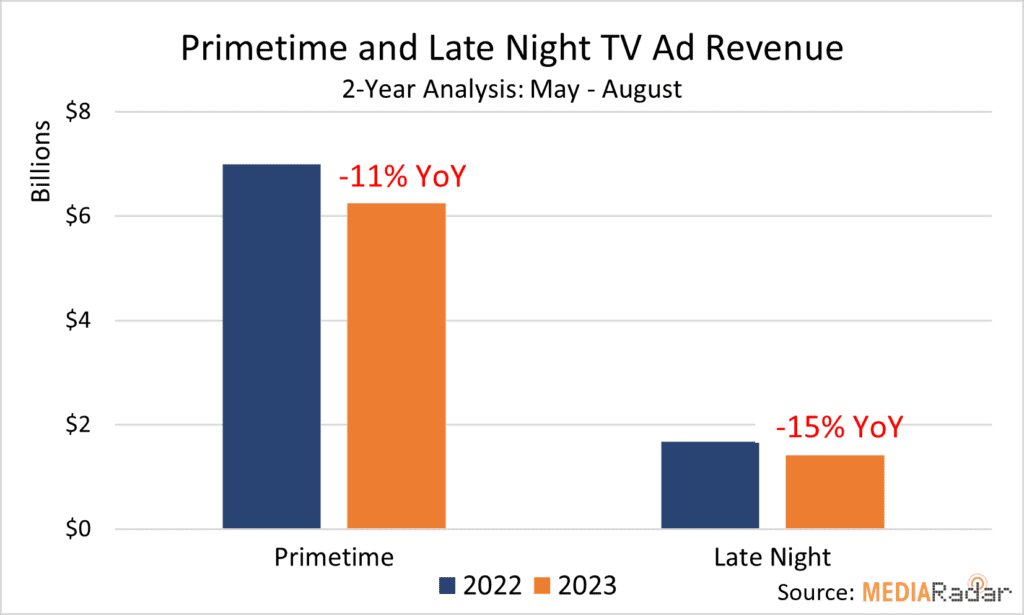The Hollywood writers’ strike that started in May 2023 has officially ended as of September 27th. After nearly five months, the Writers Guild of America (WGA) reached an agreement with studios allowing writers to return to work. However, actors represented by the Screen Actors Guild (SAG) remain on strike as negotiations continue.
“TV broadcasters saw an 11% decline since the strike began,” said Todd Krizelman, CEO, MediaRadar. “WGA’s vote allows lucrative late-night talk shows to return on air and alleviates reruns for primetime shows. It’ll be interesting to see the impact of SAG’s continued strike and how advertisers may shift media spend due to stockpiled movie content becoming scarce.”
What does the end of the writers’ strike mean for the advertising industry? And how will the ongoing actors’ strike continue to impact media companies and advertisers? MediaRadar, the leading ad sales intelligence platform, analyzes the latest data and trends.

Key Takeaways
- TV advertising revenue is down 11% year-over-year (YoY) since the strikes began. Brands have spent $14.4 billion on TV ads from May to August 2023, compared to $16 billion in 2022.
- Late-night talk shows specifically have been off-air for months in support of their writers. They drive significant ad revenue that broadcasters want back.
- Streaming services have relied on stockpiled content but may soon face impacts from the actors’ strike. New programming and filming are halted.
- With the writers’ strike over, advertising spend is likely to increase on TV, however, the actors’ strike continues to create uncertainty.
TV Advertising Revenue Down 11% Since Strikes Began
During the writers’ strike from May to August 2023, MediaRadar data shows TV advertising revenue was $14.4 billion, down 11% from $16 billion during the same period in 2022. The number of brands advertising on TV also declined 3% year-over-year, from 9.9k to 7.2k.
This decline in TV ad investment indicates how impactful the Hollywood strikes have been for broadcasters and media companies. With a lack of working writers preventing the creation of new content, networks relied on reruns and unscripted programming, reducing audiences and dimming the appeal for advertisers.
Primetime and late-night programming – which rely heavily on scripted content – saw even steeper declines per MediaRadar data. Primetime ad revenue was down 11% YoY since May at $6.2 billion. Late-night revenue decreased 15% YoY to $1.4 billion.

Key Programs Impacted: Talk Shows, Soap Operas, Sitcoms
During the strike period of May to August 2023, TV talk shows, soap operas, and sitcoms generated an estimated $1.6 billion in ad revenue. That’s 11% of the $14.4b of TV ad revenue.
Talk shows have been especially affected, with a 6% YoY ad revenue decrease to $300 million. The Drew Barrymore Show saw a significant 26% YoY decline.
Soap operas and sitcoms fared slightly better, with ad revenue increases of 21% and 2% respectively. However, soap operas never stopped producing new content, since their SAG-AFTRA actors are employed under the Network Code. For advertisers, soaps became a safe bet to invest in and ensure new programming. Sitcoms also lucked out because their programming was on a natural summer hiatus. The new fall lineups for sitcoms were expected to be released in September, which will feel an impact for some time as everyone “catches up” post-strike.
What the Writers’ Strike End Means for TV Advertising
With writers returning to work, late-night talk shows like Jimmy Kimmel and Stephen Colbert will be the first programs to return with new episodes. The return of late-night programming with star hosts could entice advertisers back to TV. These shows also tend to respond quickly to current events happening during the strike, which audiences crave.
Primetime sitcoms and dramas may take more time to get new episodes written, cast, and into production. But the end of the writers’ strike provides optimism for networks’ content pipelines.
Over the coming months, TV ad revenue is expected to improve with the writer’s strike resolved. However, the ongoing actors’ strike continues to put pressure on advertisers and media companies.
Actors’ Strike Creates Uncertainty for Streaming Services
While streaming platforms like Netflix, Hulu, and Amazon Prime Video have benefited during the strikes by airing stockpiled content, they also face challenges if the actors’ strike persists.
MediaRadar estimates streaming services invested $1.3 billion to advertise subscriptions and original content in the first eight months of 2023. This figure already represents a 12% YoY decline.
From May to August 2023, MediaRadar data shows that estimated ad spend by streaming services decreased 23% compared to the prior year, down to $547 million. New shows and filming remain halted by the actors’ strike, limiting the ability to market fresh content.
Streamers have continuously added new series and movies to lure subscribers. But without actors, studios cannot produce programming in the pipeline. While back catalogs provide short-term padding, an extended SAG strike could disrupt streaming services’ output of buzzworthy originals.
Looking Forward: Potential Timeline and Impact on Advertising
Looking ahead, MediaRadar expects advertising spend to continue shifting in response to the changing dynamics around the Hollywood strikes. If the SAG strike persists through the fall season, TV networks will likely push more ad dollars into live sports and news programming. Advertisers may accelerate spending into streaming, digital video, and CTV ads to compensate for declining TV audiences. Some brands may even pull back traditional media budgets if primetime programming remains scarce into mid-2024.
However, if an agreement can be reached with actors within the next 2-3 months, expect TV ad revenue to rebound during the important Q4 holiday season. With production lead times, the new scripted fall series wouldn’t return until late 2023 at the earliest. However, a resolution in early 2023 could allow networks to promote fresh content and encourage advertisers to commit budgets for the 2024 TV season. While unpredictable, MediaRadar will closely track the trends in ad spend across channels as talks continue between studios and Hollywood talent.
More stability and clarity for advertisers should return with writers back at work. But media companies are not out of the woods until a resolution with actors is finalized. As negotiations continue, MediaRadar will monitor the data and trends across TV, streaming, online media, and additional platforms.



